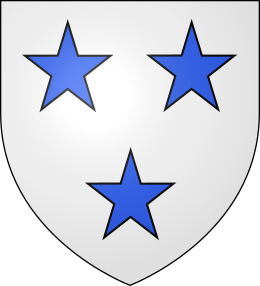Clan Innes facts for kids
Quick facts for kids Clan Innes |
|||
|---|---|---|---|

Crest: A boar's head erased Proper.
|
|||
| Motto | Be Traist (be faithful) | ||
| Profile | |||
| Region | Highlands | ||
| District | Moray | ||
| Plant badge | Great Bulrush | ||
| Chief | |||
 |
|||
| Charles Robert George Innes | |||
| 11th Duke of Roxburghe | |||
| Seat | Floors Castle | ||
| Historic seat | Innes House (1640–1767) | ||
|
|||
|
|||
|
|||
Clan Innes is a famous Scottish clan. It comes from both the Highlands and the Scottish Lowlands. The clan gets its name from the Innes lands in Moray, Scotland. The main leader of the clan is usually the Duke of Roxburghe. This is because he is a direct descendant of the Innes Baronets, who were the original chiefs.
History of Clan Innes
The Innes clan believes its story began with a knight named Berowald. He was a Flemish knight, meaning he came from a region that is now part of Belgium and the Netherlands. In 1160, Malcolm IV of Scotland gave Berowald the lands of Innes.
Berowald's grandson, Walter, later took the name Innes as his family name. In 1226, Alexander II of Scotland officially confirmed Walter's right to these lands. This was done through a special document called a charter.
In 1452, Robert Innes, who was the eleventh laird (or landowner) of Innes, fought in the Battle of Brechin. He fought alongside the Earl of Huntly. After the battle, Robert founded the Greyfriars of Elgin. This was a religious house, and he did it to make up for his past actions.
A later chief, Sir Robert Innes, was the twentieth chief of the clan. He was a Member of Parliament for Moray. This meant he helped make laws for the country. In 1625, he was given a special title: a baronet of Nova Scotia. This was a title of honor given by the King.
The third baronet, Sir James, married Lady Margaret Ker. Through this marriage, the Innes family later inherited the title of Duke of Roxburghe. This happened when the sixth baronet became the Duke.
In 1805, the twenty-fifth chief, Sir James Innes, claimed the dukedom of Roxburghe. The previous duke had passed away without any direct children. In 1812, the House of Lords (a part of the British Parliament) decided that Sir James was the rightful heir.
Because of this decision, Sir James changed his family name to Innes-Ker. He became known as James Innes-Ker, 5th Duke of Roxburghe. Today, the current Duke of Roxburghe is the heir to the clan's leadership. However, because his name is Innes-Ker, the Lord Lyon King of Arms does not officially recognize him as the chief of the Innes name. The Lord Lyon King of Arms is the official who deals with Scottish heraldry and titles.
Clan Symbols: Heraldry
Every clan has special symbols. For Clan Innes, members can wear a crest badge. This badge shows a boar's head erased Proper. This means it's a boar's head that looks like it was torn off, and "Proper" means it's shown in its natural colors.
The badge also includes the clan's heraldic motto. A motto is a short phrase that expresses a guiding idea. For Clan Innes, the motto is BE TRAIST, which means "be faithful."
Clan Tartans
Clan Innes has two main historical tartan patterns. These are called "Innes Red" and "Innes Hunting."
The "Innes Red" tartan was the first one discovered. There are different versions of it. The most well-known version is called "Innes (Of Moray)" in the Scottish Register of Tartans. Other versions include "Innes (D C Stewart)" and simply "Innes." The "Innes (of Moray)" is the one most often used today.
The "Innes Hunting" tartan is a newer discovery. It was officially registered in the Scottish Register of Tartans in 1969. This was done by Colin Innes of Tulchan, with the Duke of Roxburghe's agreement. This tartan looks exactly like the "Innes (miniature)" tartan. That miniature tartan was found on a small painting of Georgina Innes at Edingight.
There are also other tartans registered for Clan Innes. These include "Innes of Cowie," "Innes Dress," and "Innes Red, Dress (Dance)."
See also
- Innes Baronets


